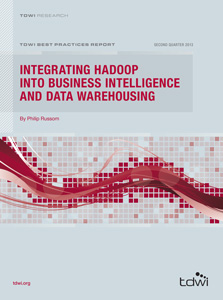
TDWI Best Practices Report | Integrating Hadoop into Business Intelligence and Data Warehousing
April 1, 2013
TDWI anticipates that Hadoop technologies will soon become a common and valuable complement to established products and practices for business intelligence (BI), data warehousing (DW), data integration (DI), and analytics. Therefore, a wide range of user organizations need to prepare for Hadoop usage. Although Hadoop can be valuable as an analytic silo, most organizations will prefer to get the most business value out of Hadoop by integrating it with—or into—their BI, DW, DI, and analytics technology stacks. This TDWI Best Practices Report takes a careful look at the benefits, barriers, and emerging best practices for integrating Hadoop into BI and DW.
The report begins by defining what Hadoop is and does—as well as what it does not do so well. It busts some of the most common myths and misconceptions harbored about Hadoop today. For example, we explain that Hadoop is really an ecosystem of products and technologies, and help you sort out its components. Next, the report discusses applications of Hadoop in BI/DW and strategies for integrating Hadoop with BI/DW technology stacks. It clarifies the business and technology situations in which Hadoop-based BI, DW, DI, and analytics can be most useful, and describes how certain product combinations are more desirable than others for such applications.
Hadoop is still rather new, and it’s often deployed to enable other practices that are also new, such as big data management and advanced analytics. Rationalizing an investment in Hadoop can be problematic. This report will help you sort out which Hadoop products are in use today and will be in the near future.
Hadoop promises to assist with the toughest challenges in BI today, including big data, advanced analytics, and multi-structured data. Download the full report to learn more about how to integrate Hadoop with your business intelligence, analytics, data integration, and data warehousing programs.